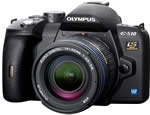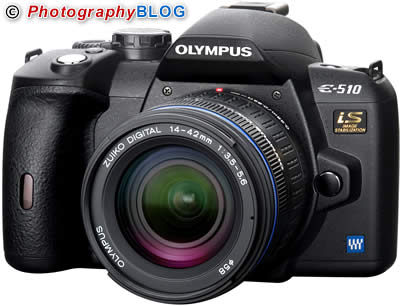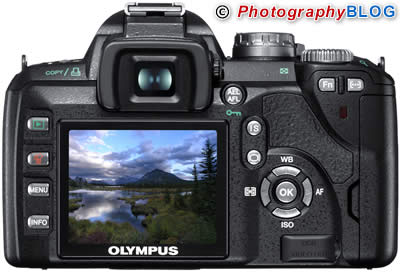Olympus E-510
 PMA 2007: The Olympus E-510 DSLR camera features a built-in image stabiliser in the camera body. The E510 also has a new image processing engine that offers excellent noise performance and 3fps with a seven image RAW buffer in burst mode. Based on the Four Thirds Standard, the Olympus E-510 replaces the older E-500 model and offers a new 10 megapixel Live MOS sensor, Live Preview on the 2.5 inch LCD screen and a Supersonic Wave Filter for dust protection. The Olympus E510 will be available in June 2007 for around £600 body only, £700 in a kit with the 14-42mm lens, and £800 with the 14-42mm and 40-150mm lenses.
PMA 2007: The Olympus E-510 DSLR camera features a built-in image stabiliser in the camera body. The E510 also has a new image processing engine that offers excellent noise performance and 3fps with a seven image RAW buffer in burst mode. Based on the Four Thirds Standard, the Olympus E-510 replaces the older E-500 model and offers a new 10 megapixel Live MOS sensor, Live Preview on the 2.5 inch LCD screen and a Supersonic Wave Filter for dust protection. The Olympus E510 will be available in June 2007 for around £600 body only, £700 in a kit with the 14-42mm lens, and £800 with the 14-42mm and 40-150mm lenses.
Olympus UK Press Release
Take confident, professional shots with ease and control
The Olympus E-510: D-SLR with Live Preview and built-in image stabiliser for ease and clarity
London, 5 March 2007 – It’s about forethought, professional specifications and the seamless integration of cutting-edge technology: The Olympus E-510 delivers nothing short of impeccable performance. This successor to the E-500 gives photographers a better way to frame their compositions since – unlike most D-SLRs – it boasts Live Preview on its 2.5”/6.4cm HyperCrystal LCD. Olympus proves itself once again as a technology leader with this camera’s built-in image stabiliser, which incorporated directly into the body, so there’s no need for the costly inclusion of a stabiliser in each lens. Experience dramatically improved shooting results with a new image processing engine that offers excellent noise performance – thus bringing picture quality to a whole new level. And, as with all of its E-System cameras, Olympus eliminates the threat of dust with Supersonic Wave Filter. What’s more, the addition of a new Live MOS sensor in this Four Thirds- based camera delivers 10 Megapixels of high-quality detailed photography.
Advanced technology for superior photography
Settle for nothing less than the latest in imaging technology. Living up to its reputation as one of the world leaders in digital photography, Olympus has equipped the body of the E-510 with an image stabiliser – so there’s no need to have it in every lens, as is the case with other D-SLRs. Enjoy protection against blur caused by camera shake when working with long exposure times or high magnifications: Don’t risk blurring a shot in high action situations, or when there’s no tripod at hand. All that you need to protect images against unwanted camera shake has been built into the body of this powerful addition to the E-System. And enjoy true-to-life colour reproduction along with exceptional noise performance thanks to the new image processing engine.
The incorporation of Live Preview takes D-SLR photography in a new and exciting direction, ensuring picture sharpness with unprecedented accuracy: The ability to view images on the 2.5”/6.4cm HyperCrystal LCD at magnifications of 6x or 10x in manual focus mode guarantees that pictures always come out sharp. Auto-focusing is as easy as a push of the AEL button. A quick flip up and then down of the mirror allows the AF measurement to be made – and shooting can begin. Furthermore, with superb image processing speeds of 3fps with a seven image RAW buffer in burst mode, there’s no need to worry about missing a great shot.
Comfort and control
Indulge in the simple convenience of smart design. With both exposure and WB compensation available for viewing directly on the LCD, it’s a cinch to adjust to the perfect light and colour settings. There’s even a histogram function to allow for exceptionally accurate exposure control. The E-510 is one-of-a-kind. Not only does it have the power to satisfy the seasoned professional with an array of manual settings, there are also 18 easy-to-use scene programmes, such as Macro and xD Panorama, allowing virtually anyone to get in on the action. The incorporation of colour modes plus Black&White filters adds another dimension to this D-SLR’s enticing list of creative features.
There’s a choice of data storage options in the E-510 with slots for both the xD-Picture Card, and CompactFlash cards – so photographers upgrading from using an Olympus compact camera can continue to use their existing cards, which even enable the use of this camera’s xD Panorama scene programme. Ten different languages on board plus a further 15 for download ensure that the E-510 remains accessible to everyone – no matter what their native tongue is – while the incorporation of Hi-Speed USB guarantees the extra-speedy transfer of pictures to a computer or photo printer. And rest assured that great shots are possible in even the most uncertain of situations: With its bracketing function, the E-510 takes a sequence of three shots in WB and Exposure mode and five shots in Focus mode, giving the photographer a choice of photos, from which the best may be selected.
A wide choice of accessories
The E-510, with a long-life rechargeable battery, is a bona fide E-System D-SLR – meaning that it’s compatible with almost the entire range of
E-System accessories. Based on the Four Thirds Standard, this exemplary range features near-telecentric lenses, which are optimised for the specific needs of digital photography in order to provide edge-to-edge colour, sharpness and brightness. Revel in the superiority of this flexible and comprehensive system of lenses, flashes and other accessories.
The Olympus E-510 is the latest example of Olympus’ commitment to imaging excellence and precision. With Live Preview, a built-in image stabiliser for even sharper shots in shaky conditions and a new engine to guarantee exceptional noise performance and overall improved results, it’s clear that this D-SLR is ready to deliver nothing less than the ultimate in professional-grade photography. This awe-inspiring addition to the E-System will become available in June 2007.
The Olympus E-510 digital SLR – main features:
• D-SLR with built-in image stabiliser
• 10 Megapixel Live MOS sensor
• Live Preview
• New image processing engine
• Hi-Speed USB 2.0
• 2.5”/6.4cm HyperCrystal LCD
• Supersonic Wave Filter for dust protection
• 28 shooting modes (incl. 5 exposure, 5 creative & 18 scene modes)
• Built-in pop-up flash (GN 10)
• 3fps with up to seven images in RAW buffer
• AF-lock functionality
• Depth of field preview function
• Bracketing function (Exposure, White Balance, Focus)
• Detailed playback info screen with histogram
• Based on Four Thirds Standard, making it compatible with almost the entire range of system accessories
Olympus E-System lens line-up*:
Top Pro lens range
• ZUIKO DIGITAL ED 7-14mm (14-28mm) 1:4.0
• ZUIKO DIGITAL ED 35-100mm (70-200mm) 1:2.0
• ZUIKO DIGITAL ED 90-250mm (180-500mm) 1:2.8
• ZUIKO DIGITAL ED 150mm (300mm) 1:2.0
• ZUIKO DIGITAL ED 300mm (600mm) 1:2.8
Pro lens range
• ZUIKO DIGITAL 11-22mm (22-44mm) 1:2.8-3.5
• ZUIKO DIGITAL 14-54mm (28-108mm) 1:2.8-3.5
• ZUIKO DIGITAL ED 50-200mm (100-400mm) 1:2.8-3.5
• ZUIKO DIGITAL ED 8mm (16mm) 1:3.5 Fisheye
• ZUIKO DIGITAL ED 50mm (100mm) 1:2.0 Macro
Standard lens range
• ZUIKO DIGITAL ED 14-42mm (28-84mm) 1:3.5-5.6
• ZUIKO DIGITAL 14-45mm (28-90mm) 1:3.5-5.6
• ZUIKO DIGITAL ED 18-180mm (36-360mm) 1:3.5-6.3
• ZUIKO DIGITAL 40-150mm (80-300mm) 1:3.5-4.5
• Extra compact ZUIKO DIGITAL ED 40-150mm (80-300mm) 1:4.0-5.6
• ZUIKO DIGITAL 35mm Macro (70mm) 1:3.5
* Figures in brackets show 35mm camera equivalents
Appendix
Four Thirds System
This is the first and currently only open standard for digital SLRs. As the name suggests, Four Thirds systems use a 4/3-type image sensor, the size of which allows the development of tailor-made interchangeable lenses. These are not only smaller and lighter, but also offer a greater
light-gathering power than lenses based on the 35mm film format. Besides Olympus, current members of the Four Thirds consortium include Kodak, Fuji, Sanyo, Sigma, Panasonic and Leica.
Live Preview
Provides an alternative to framing shots through the viewfinder on a digital SLR camera. The image sent through the lens to the image sensor is displayed directly on the camera’s LCD. Whereas most compact digital cameras have been equipped with Live Preview functionality for many years, this feature has only recently become available on D-SLRs. The world’s first D-SLR to feature continuous Live Previews was the Olympus E-330.
Supersonic Wave Filter
Dust entering digital SLRs, for example during lens changes, can cause damage to photos – unless it is removed. With the Supersonic Wave Filter, the potential for dust to ruin photos is eliminated. A transparent filter is located between the camera’s shutter and CCD. It makes sure no dust is able to land on the CCD. Instead, the particles settle on the filter and are then shaken off by a series of ultrasonic vibrations generated by the filter when activated. Olympus was the first manufacturer to incorporate dust protection in D-SLRs.
HyperCrystal LCD
A semi-transmissive technology used in LCDs, which employs an additional layer at the bottom of the LCD to reflect light from external light sources. This enhances the brightness of the LCD, so even in direct sunlight images are displayed sharply and with three times the contrast of conventional displays. Also, it provides for viewing angles of up to 170° without glare or shadow, so images can be framed from a variety of angles and viewed by several people at once.
Image stabiliser
An electromechanical system that works to prevent blur caused by camera shake, which is particularly useful at long focal distances. Gyro sensors in the camera register camera shake, and then supersonic wave drive the image sensor to compensate for unintentional camera movements. As the image stabiliser is situated in the camera, it works with each and every lens attached to the body.



Loading comments…